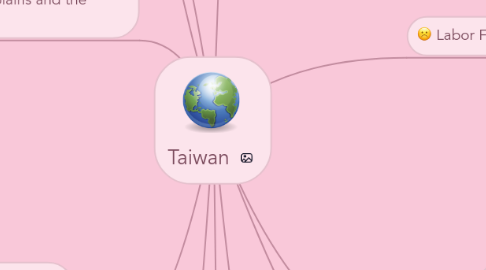
1. Demographics
1.1. Population
1.1.1. 23,190,000
1.2. Culture
1.2.1. 48.3% Non religious, but the preferred belief is Buddhism
1.3. Currency
1.3.1. $22,115,497,000,000 in Revenue
1.4. Ethnic Groups
1.4.1. Mainland Chinese and Taiwanese
2. Trade Restrictions
2.1. Don't Forget your Label!
2.2. Taiwan External Trade Development Council
2.3. ATA Carnet
3. Imports and Exports
3.1. China is Taiwan's major export destination, followed by Hong- Kong, U.S., Japan, Singapore
3.1.1. Reduced tariffs for Taiwan in the past.
3.2. Imports come from U.S., Japan, China, South Korea, and Saudi Arabia
3.3. Singtex
3.3.1. S. Cafe Fabric
4. High Technology Gadgets and Fabrics
4.1. Fabric Mills
4.1.1. Offshore
4.2. Garment Factories
5. Foreign Direct Investment
5.1. Positive FDI
5.1.1. Around 3.9 Billion
5.2. In 2011, Taiwan's outflow of FDI exceeded it's inflow. The outflow exceeded inflow by 1.96 Billion.
5.3. Most Asian economies recorded a positive FDI figure despite a drop in inflows.
6. Labor Force
6.1. Taiwan's labor force is rising with older workers, age 45 and up. This older population has risen to 49% of the work force population.
6.2. Unemployment
6.2.1. Disastisfaction
6.2.2. Business Downsizing or Closures
6.3. Migrant Workers
6.3.1. Taiwanese Manufacturers are known for bringing in migrant workers from Thailand. They can pay them wages that are below the minimal wage.
6.4. Lower Labor Costs
6.5. New Labor Rule
6.5.1. For every migrant worker that is hired, manufacturers must hire 5 local workers.
7. Traits of Taiwan
7.1. Geographical Traits
7.1.1. Located in the Western Pacific between Japan and the Philippines, off the coast of China. Taiwan has a very tropical climate with abundant rainfall; half of the island of Taiwan is covered by mountain ranges.
7.2. Political and Economical Traits
7.2.1. Dynamic, Multi-party Democracy- President Ma Ying-jeou has worked to have a more open economic relationship with China.
7.2.2. Taiwan has remained independent from having a membership with the United Nations. Taiwan has a great emphasis on services, manufacturing, and technology which makes Taiwan have one of the richest economies in Asia.
7.2.3. Taiwan is known for having one of the freest economies so far in 2013.
7.2.3.1. Business Freedom
7.2.3.2. Labor Freedom
7.2.3.3. Freedom from Corruption
7.2.4. Open Market Policies
7.2.5. Foreign Investment is welcomed
8. Resources Include: Small deposits of gold, copper, coal, natural gas, limestone, and marble. The island of Taiwan is 55 % wodland and forests, which are mostly on mountains, 24% plains and the rest goes to crops and pastures.
9. Infrastructure: Taiwan High Speed Rail, the freeway electronic toll collection system, and the Shueshan Tunnel
10. Trade Relationship with the U.S.
10.1. Taiwan is the U.S. 10th largest goods trading partner.
10.2. Imports from Taiwan to the U.S. have had a 15% increase since 2011.
10.3. Taiwan Direct Investment in the U.S. is mostly in the manufacturing, wholesale trade, and banking sectors.
10.4. The U.S. Direct Investment in Taiwan is mostly in the finance/insurance, manufacturing, and whole sale trade sectors.
11. Disadvantages and Advantages
11.1. ECFA
11.1.1. Imports to and from will increase.
11.1.1.1. Zero Tariff Policy
11.1.1.1.1. Industries will suffer under ECFA
11.2. Technology used with certain companies offer high profit potential and little pollution, but Taiwan is willing to give up these industries in favor of high polluters like chemicals, machinery, and upstream textiles.
11.2.1. High external costs and high pollution.
12. What Can Taiwan add to the Textile and Apparel World?
12.1. Charity
12.1.1. TEXMA
12.1.1.1. Recycled Polyester
12.2. Eco Friendly Textiles and apparel
12.2.1. Functional Products
